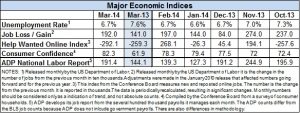 The staffing industry which has been growing jobs faster than almost any other sector of the economy was again one of the leading contributors to the economy in March, accounting for 28,500 of the 192,000 new jobs in the month.
The staffing industry which has been growing jobs faster than almost any other sector of the economy was again one of the leading contributors to the economy in March, accounting for 28,500 of the 192,000 new jobs in the month.
This morning’s report from the Bureau of Labor Statistics came in shy of the 200,000 jobs that analysts were expecting, but showed that U.S. workers who have been out of the job market for months, are rejoining the labor force. In March, some 500,000 workers resumed looking for work, and all but about 27,000 found jobs. That kept the unemployment rate at 6.7%.
Initial numbers for January and February were revised upward in the report, growing their total by 37,000 more jobs. With the revisions, monthly job growth during the first quarter of the year averaged 177,700 new jobs versus 206,000 for the first quarter last year.
Temp jobs have increased by 56,100 since January and continue to set new highs each month for the industry. Today’s report puts the number of temp workers at 2.837 million on a seasonally adjusted basis.
The staffing industry typically grows more rapidly than other sectors during the early stages of a recovery, as uncertain employers hesitate about hiring perms, yet need workers because of improving business. However, in this slow economy, growth in the temp industry has been steady, even increasing, as employers see temp and contract labor as a strategic part of their workforce, and not merely fill-ins.
Nonetheless, analysts see the growth in temp as a positive economic sign. Joseph LaVorgna, chief U.S. economist at Deutsche Bank, in a note to investors after this morning’s jobs numbers were released, said, “Temp hiring was up a solid 29k, which is a leading indicator of future labor demand.”
Workers are even more optimistic, as shown both in the inflow of workers to the labor force and improvement in The Conference Board’s Consumer Confidence Index, which stands at 82.3, up from 78.3 and well above the 61.9 in March of last year.
The labor report showed many sectors of the economy added workers:
- Restaurants and bars up by 30,400 employees.
- Retailers +21,300, with food and beverage stores adding 9,000 new jobs.
- Construction jobs increased by 19,000, for a net gain of 37,000 since January.
- Health +19,400.
- Computer systems design and related +6,100.
- Transportation and warehousing +7,900.
The broad manufacturing sector lost 1,000 jobs, but that was due to a decline in the non-durable goods area, with the food manufacturing industry dropping 4,600 jobs. Durable goods manufacturers — those who make such things as machinery, office equipment, appliances, and cars and trucks — added 8,000 workers.
Overall, the report is considered a mixed bag by economists, who mostly see it as confirmation that the economy is continuing to improve, but slowly.
Millan L. Mulraine, deputy head, U.S. research & strategy, TD Securities USA, summed up the reaction of analysts when he wrote in an analyst note, “The main takeaway from this report is that the labor market is continuing to bounce out of the weather-induced slump of earlier this year, and while the pace of rebound remains slower than we expected, we take encouragement from the strong showing in almost every other aspect of this report.”